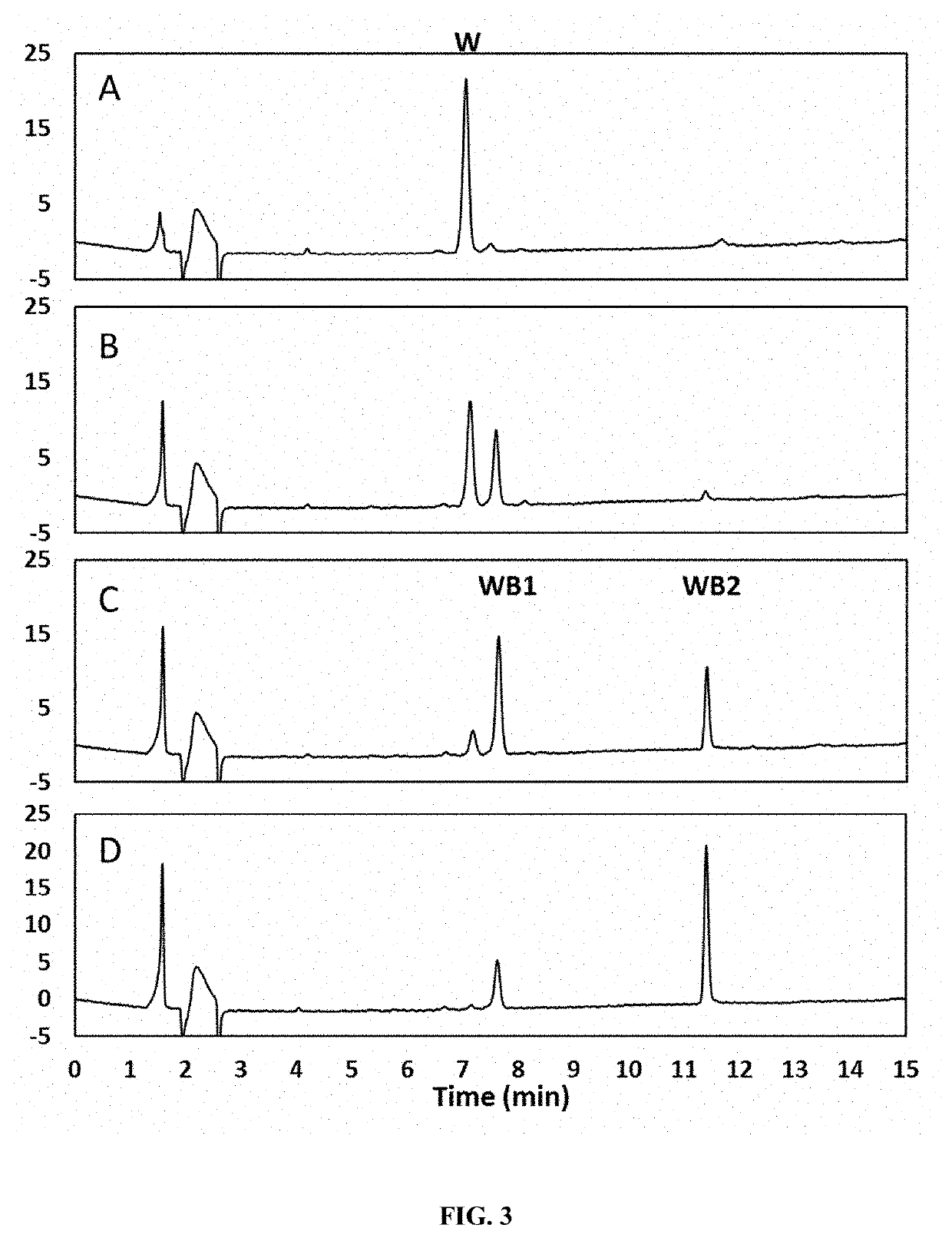Biosynthetic production of steviol glycosides and processes therefore
a technology of steviol glycosides and biosynthetic production, which is applied in the direction of transferases, bakery products, chewing gum, etc., can solve the problems of insufficient steviol rebaudiosides, cost and resource prohibitive, and insufficient steviol rebaudiosides in individual or specific combinations that are not abundant in i>stevia/i>extracts,
- Summary
- Abstract
- Description
- Claims
- Application Information
AI Technical Summary
Benefits of technology
Problems solved by technology
Method used
Image
Examples
example 1
Synthesis of Reb D4
[0169]There are several enzymatic methods of making Reb D4. One of the method starting from Reb W is presented here.
[0170]Previously, we demonstrated the production of Reb W from Reb V (WO2016054540). Here, we found Reb W can be hydrolyzed by beta-glucosidase (B-glu1, SEQ: 5) from Pichia pastoris to produce a novel steviol glycoside we called it “Rebaudioside WB1”. The produced Rebaudioside WB1 can be hydrolyzed in turn by B-glu1 to produce Rebaudioside WB2. (see, FIG. 14).
[0171]More specifically, the full-length DNA fragments of B-glu1 (SEQ ID NO: 6) gene was synthesized. Specifically, the cDNA was codon optimized for E. coli expression (Genscript, Piscataway, N.J.). The synthesized DNA was cloned into a bacterial expression vector pETite N-His SUMO Kan Vector (Lucigen). The nucleotide sequence (SEQ ID NO: 6) encoding the B-glu1 (see, SEQ ID NO:5) was inserted in frame.
[0172]The expression construct was transformed into E. coli BL21 (DE3), which was subsequently ...
example 2
g Reb D4 to Reb M by Wild Type Enzyme
[0181]We discovered that the Reb D4 can be further converted to Reb M by UGT76G1. The full-length DNA fragments of UGT76G1 (SEQ ID NO: 2) was synthesized. The cDNA was codon optimized for E. coli expression (Genscript). The synthesized DNA was cloned into a bacterial expression vector pETite N-His SUMO Kan Vector (Lucigen). The nucleotide sequence encoding the 76G1 was inserted in frame.
[0182]The expression construct was transformed into E. coli BL21 (DE3), which was subsequently grown in LB media containing 50 μg / mL kanamycin at 37° C. until reaching an OD600 of 0.8-1.0. Protein expression was induced by addition of 0.5 mM IPTG and the culture was further grown at 16° C. for 22 hr. Cells were harvested by centrifugation (3,000×g; 10 min; 4° C.). The cell pellets were collected and were either used immediately or stored at −80° C.
[0183]The cell pellets were re-suspended in lysis buffer as described above. The cells were disrupted by sonication at...
example 3
the Reaction Centers of UGT Enzymes Catalyzing Reb D4 to Reb M
[0187]To more efficiently determine the chemical processes of the UDP-glucosyl transferase we obtained the crystal structure of a wild type steviol UDP-glucosyl transferase UGT76G1. This enzyme is the first reported enzyme that carry out steviol glycoside bio-conversions. We want to acquire the structural information of the reaction center and substrate binding sites to design enzymes for Reb D4 to Reb M conversion to understand it more completely and thereafter use this knowledge to find more efficiently find or design enzymes that can be useful in the Reb D4 to Reb M bioconversion.
[0188]For production of selenomethionine (SeMet)-substituted protein, Escherichia coli BL21 (DE3) cells were transformed with the pET-28a-UGT76G1 vector and grown in M9 minimal media supplemented with SeMet (Doublie, 2007) containing 50 ug mL-1 kanamycin at 37° C. (250 rpm) until A600 nm-0.8. Addition of isopropyl 1-thio-β-D-galactopyranoside ...
PUM
| Property | Measurement | Unit |
|---|---|---|
| reaction temperature | aaaaa | aaaaa |
| reaction temperature | aaaaa | aaaaa |
| reaction temperature | aaaaa | aaaaa |
Abstract
Description
Claims
Application Information
 Login to View More
Login to View More - R&D
- Intellectual Property
- Life Sciences
- Materials
- Tech Scout
- Unparalleled Data Quality
- Higher Quality Content
- 60% Fewer Hallucinations
Browse by: Latest US Patents, China's latest patents, Technical Efficacy Thesaurus, Application Domain, Technology Topic, Popular Technical Reports.
© 2025 PatSnap. All rights reserved.Legal|Privacy policy|Modern Slavery Act Transparency Statement|Sitemap|About US| Contact US: help@patsnap.com



